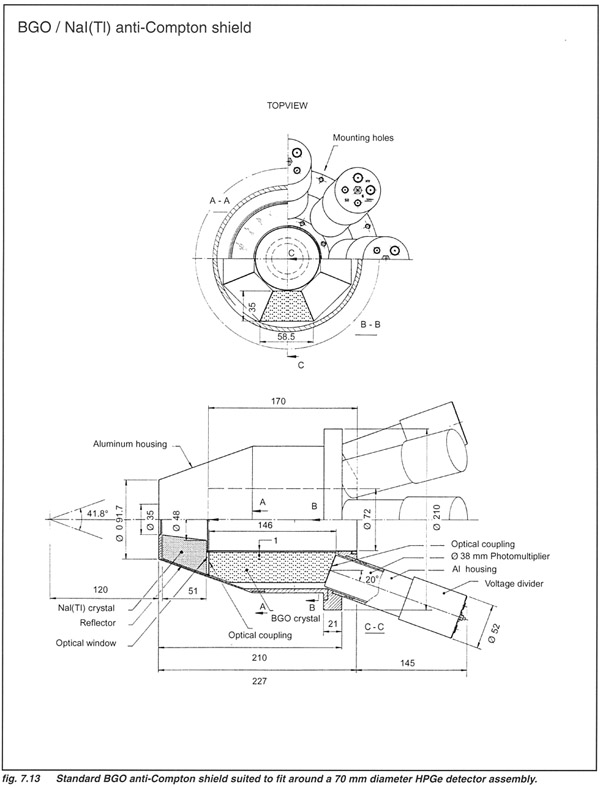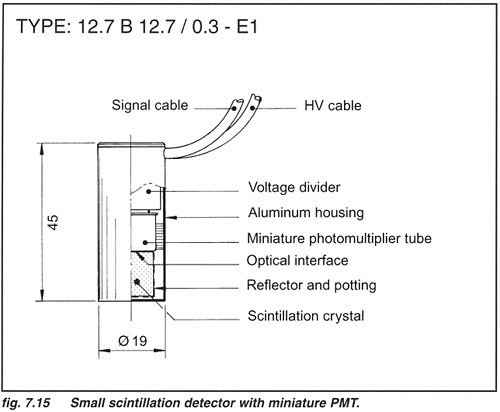 |
In fact, many SCIONIX scintillation detectors are custom-made with detector configuration and materials adapted to the specific requirements of the user. Regarding the special applications we would like to mention here anti-Compton shields, scintillation detectors with miniature PMTs and phoswiches. Anti-Compton (AC) systems are scintillation detector assemblies mounted around a High Purity Ge-detector (HPGe) that detect the gamma rays Compton scattered by the Ge crystal and generate a veto signalwhen such a Compton event occurs. This improves the peak-to-total ratio in the pulse height spectrum of the Ge detector significantly. Crucial parameters are a large solid angle coverage around the HPGe detector and high stopping power. The use of segmented well-type BGO detectors is the generally accepted optimum approach, except for low background systems where the intrinsic high background of BGO is prohibitive and NaI(Tl) is normally used. Below some examples are shown. AC-shields can be provided with special backcatcher detectors around the cryostat arm for optimum solid angle coverage. To save cost, BGO AC-shields are often equipped with a NaI(Tl) "nose" since at these angles scattered energies are low and a high stopping power is not required. Many options are possible and we advise to contact SCIONIX to discuss the optimum AC shield configuration for your Ge detector assembly. |
||||||||||||||
 |
||||||||||||||
 |
||||||||||||||
 |
||||||||||||||
| BACK TO TOP | ||||||||||||||
|
The recent development of miniature mesh-type dynode photomultiplier tubes has opened up some possibilities to construct short small diameter detector assemblies. The active area of these devices is around 1 - 2 cm which limits the diameter of scintillation crystals that can be used. The detectors are equipped with built-in voltage dividers. Miniature scintillation detectors are useful in applications where space is limited. Miniature PMTs are rugged and quite insensitive to magnetic fields. Below an example is presented. As an option, assemblies with built-in high voltage generator are available. |
||||||||||||||
| BACK TO TOP | ||||||||||||||
|
Phoswiches are detectors employing a combination of two different scintillation materials. The application is low intensity detection of X-rays and a- or b-particles in the presence of a g-ray background. The (thin) primary scintillation crystal detects the radiation of interest and the secondary (guard) crystal detects background absorptions in the guard crystal and radiation that is scattered by the primary crystal and is absorbed in the guard crystal. This last aspect implies that by setting a veto in case of a time coincidence in signals between primary and guard crystal, the background contribution from the primary crystal can be reduced. Both primary and guard crystal are read out with the same PMT. Whether a signal in the PMT originated from the primary or the guard crystal is determined by choosing scintillation materials having different decay times. The most frequent combination is a NaI(Tl) and CsI(Tl) phoswhich (effective decay time 0.25 ms and 1 ms) for low energy X-ray detection or a CaF2(Eu)/ NaI(Tl) phoswich for low background a- and b-particle detection. Signal separation is done by pulse shape analysis for which it is important that the decay times of the two scintillators are sufficiently different. |
||||||||||||||
 |
||||||||||||||
Large well detector (10cm diameter x 20cm deep well) |
||||||||||||||
 |
||||||||||||||
76 and 127mm diameter spherical NaI(Tl) detectors for optimal uniform sensitivity |
||||||||||||||
| BACK TO TOP | ||||||||||||||